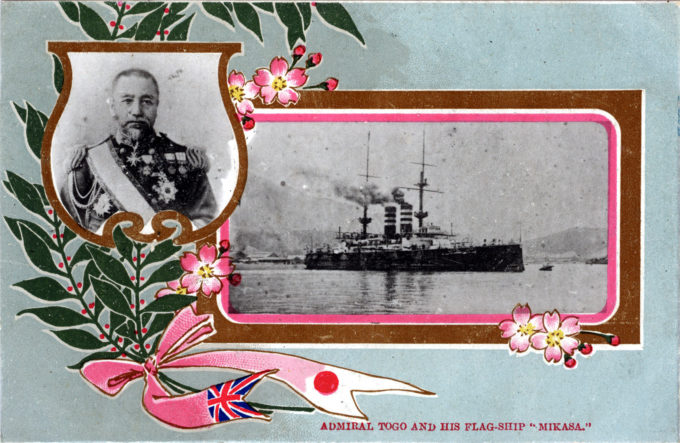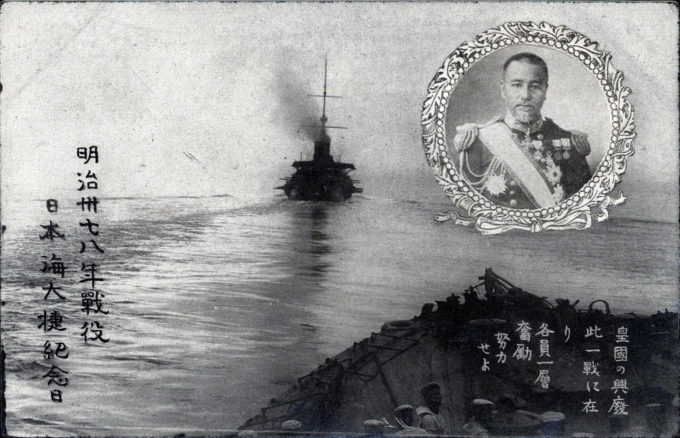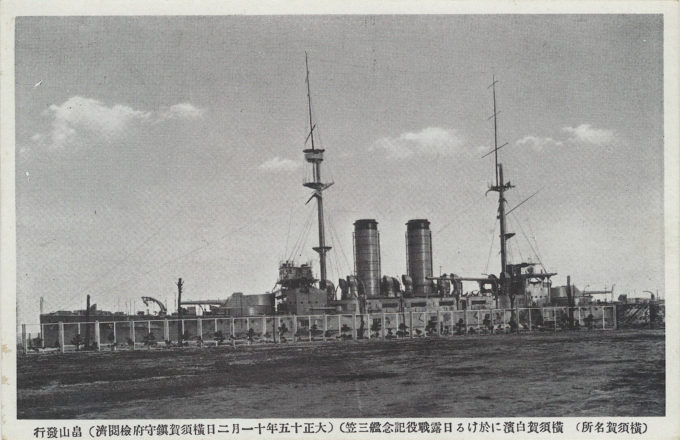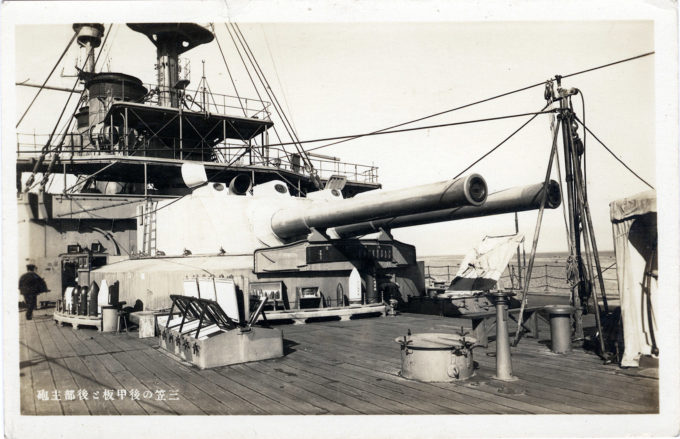
“Admiral Togo and his flag-ship ‘Mikasa‘,” c. 1910, constructed at Vickers shipyard in Barrow-in-Furness, UK, in 1898. After the Sino-Japanese War (1895), the Imperial Japanese Navy promulgated a ten-year naval build-up program with the construction of six battleships and six armored cruisers at its core. Lacking the technology and capability at the time to construct its own battleships, Japan turned to the United Kingdom for construction of the battleships. The design of Mikasa was a modified version of the Formidable-class battleships of the UK Royal Navy.
See also:
Memorial battleship “Mikasa”, Yokosuka, c. 1930.
“This is the Japanese greatest admiral …”, Admiral Togo, 1906.
Japanese curry, Officer’s mess, Battleship Mikasa, c. 1906.
“MIKASA, a Japanese battleship that took part in the Russo-Japanese War. She was the only ship built of the planned Mikasa-class and the final battleship completed of the 1896 naval program … Considered the world’s most powerful battleship of her time, Mikasa belonged to the leading 1st Battle Division of the First Fleet at the outbreak of the war. As the flagship of Admiral Togo Heihachiro and the whole Combined Fleet, she took part in all of the major naval operations of the Imperial Japanese Navy during the Russo-Japanese War.”
– The A to Z of the Russo-Japanese War, by Rotem Kowner, 2009
“The great Naval Battle of the Japan Sea which was fought and won by Japan has few parallels in the annals of naval warfare in the completeness of her victory.
“The [Russian] Baltic Fleet, which drew so much attention of the world during its long journey extending over nine months, was almost annihilated by the Japanese Squadron in less than two days immediately on its arrival in Japan waters. In fact, at first many people were inclined to doubt the authenticity of the reports on account of the thoroughness of victory on the one side and that of defeat on the other. The bubble of the boasted strength of the Baltic fleet burst at the first touch of the Japanese gun-shot.
“[G]athering the various intelligences so far published into something like coherence it appears that the first notice of the approach of the Baltic Squadron was received by wireless telegraph at the Japanese naval base at 5.30 a.m. on May 27th. The flagship Mikasa at once ordered the warships to prepare to leave. The Japanese Squadron went out of their rendezvous in splendid order and steered their course towards the eastern channel of Tsushima Straits. All the crews of all the ships were stimulated with high spirits, and keyed to the highest pitch of ardour.
“… At about 11.30 a.m. a wireless message was received by the main detachment to the effect that the Russian squadron was passing the Eastern channel … The Russian squadron was in two lines ahead and the number of the Russian ships was at the time indeterminable. The line was drawn so long that the rear of the Russian line was almost invisible. Its appearance was awe inspiring.
“At 2 p.m. the Japanese ships raised their battle flag, and the flagship Mikasa signalled, ‘The rise or fall of the Empire depends on this conflict. Let all officers and men fight with all their might.'”
– The Naval Battle of the Japan Sea, Published by the Eisho Shuppan Sha (Yokohama), 1905

Battleship Mikasa and Combined Fleet Admiral Togo (inset photo), 1905, leading the line of battle against the Russian fleet at the Battle of Tsushima Straits, the first decisive sea battle fought by modern steel battleship fleets. At the lower right, the postcard is captioned “Being in the Empire’s world war, let each member work harder. In the 38th year of Meiji, the great victory of Japan.”
“In 1905, when the Japanese outfought the Russians, notably in Admiral Togo’s victory over the Baltic fleet in the straits of Tsushima between Japan and Korea, they still had not mastered the technology of building a battleship. Togo’s flagship Mikasa had been built and armed, like all Japanese capital ships to this point, by British companies. Today, thanks for extraordinary circumstances and effort the Mikasa, once sunk, once almost scrapped, and at one point made into a dance hall, has been restored and berthed at Yokosuka alongside a statue of Togo Heihachiro.
“This denouement owes much to Japanese patriotic sentiment, which made the decommissioned vessel into a memorial in 1926, but its postwar reconstruction was sparked, surprisingly, by Admiral Chester W. Nimitz, vanquisher of the Imperial Navy and witness to Japan’s surrender aboard the battleship Missouri in 1945.
“Nimitz, it turned out, had admired Togo since his days as a midshipman and had never forgotten his brief, cordial meeting with the admiral at a Tokyo garden party in the summer of 1905. In 1934 he represented the U.S. Navy at the admiral’s funeral. Consequently, soon after arriving in Yokosuka in 1945, Nimitz paid a visit to the Mikasa and ordered a guard on board to prevent looting. (Already the Russians were reported to have reclaimed their surrender flag.)”
– Meiji Revisited: The Sites of Victorian Japan, by Dallas Finn, 1995

Museum battleship Mikasa, Yokosuka, c. 1926, after its installation in concrete at Yokosuka Naval Arsenal following its decommissioning as a result of the Washington Naval Treaty of 1922.


